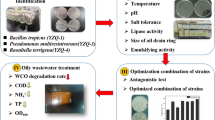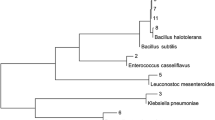Abstract
There is emerging interest in the anaerobic degradation of crude oil. However, there is limited knowledge about the geochemical effects and microbiological activities for it. A mixture of anaerobic sludge and the production water from an oil well was used as an inoculum to construct four consortia, which were incubated under sulfate-reducing or methanogenic conditions at either mesophilic or thermophilic temperatures. Significant degradation of saturated and aromatic hydrocarbons and the changing quantities of some marker compounds, such as pristane, phytane, hopane and norhopane, and their relative quantities, suggested the activity of microorganisms in the consortia. Notably, the redox conditions and temperature strongly affected the diversity and structure of the enriched microbial communities and the oil degradation. Although some specific biomarker showed larger change under methanogenic condition, the degradation efficiencies for total aromatic and saturated hydrocarbon were higher under sulfate-reducing condition. After the 540-day incubation, bacteria of unknown classifications were dominant in the thermophilic methanogenic consortia, whereas Clostridium dominated the mesophilic methanogenic consortia. With the exception of the dominant phylotypes that were shared with the methanogenic consortia, the sulfate-reducing consortia were predominantly composed of Thermotogae, Deltaproteobacteria, Spirochaeta, and Synergistetes phyla. In conclusion, results in this study demonstrated that the different groups of degraders were responsible for degradation in the four constructed crude oil degrading consortia and consequently led to the existence of different amount of marker compounds under these distinct conditions. There might be distinct metabolic mechanism for degrading crude oil under sulfate-reducing and methanogenic conditions.






Similar content being viewed by others
References
Agrawal A, Gieg LM (2013) In situ detection of anaerobic alkane metabolites in subsurface environments. Front Microbiol 4:140
Aitken CM, Jones DM, Larter SR (2004) Anaerobic hydrocarbon biodegradation in deep subsurface oil reservoirs. Nature 431:291–294
Bennett B, Fustic M, Farrimond P, Huang H, Larter SR (2006) 25-norhopanes: Formation during biodegradation of petroleum in the subsurface. Org Geochem 37:787–797
Boopathy R, Shields S, Nunna S (2012) Biodegradation of crude oil from the BP oil spill in the marsh sediments of Southeast Louisiana, USA. Appl Biochem Biotechnol 167:1560–1568
Brooks PW, Fowler MG, Macqueen RW (1988) Biological marker and conventional organic geochemistry of oil sands/heavy oils, Western Canada basin. Org Geochem 12:519–538
Callaghan AV, Gieg LM, Kropp KG, Suflita JM, Young LY (2006) Comparison of mechanisms of alkane metabolism under sulfate-reducing conditions among two bacterial isolates and a bacterial consortium. Appl Environ Microbiol 72:4274–4282
Callaghan AV, Wawrik B, Ni Chadhain SM, Young LY, Zylstra GJ (2008) Anaerobic alkane-degrading strain AK-01 contains two alkylsuccinate synthase genes. Biochem Biophys Res Commun 366:142–148
Cheng L, He Q, Ding C, Dai LR, Li Q, Zhang H (2013) Novel bacterial groups dominate in a thermophilic methanogenic hexadecane-degrading consortium. FEMS Microbiol Ecol 85:568–577
da Cruz GF, de Vasconcellos SP, Angolini CF, Dellagnezze BM, Garcia IN, de Oliveira VM, dos Santos Neto EV, Marsaioli AJ (2011) Could petroleum biodegradation be a joint achievement of aerobic and anaerobic microorganisms in deep sea reservoirs? AMB Express 1:47
Gieg LM, Duncan KE, Suflita JM (2008) Bioenergy production via microbial conversion of residual oil to natural gas. Appl Environ Microbiol 74:3022–3029
Gieg LM, Davidova IA, Duncan KE, Suflita JM (2010) Methanogenesis, sulfate reduction and crude oil biodegradation in hot Alaskan oilfields. Environ Microbiol 12:3074–3086
Gray ND, Sherry A, Larter SR, Erdmann M, Leyris J, Liengen T, Beeder J, Head IM (2009) Biogenic methane production in formation waters from a large gas field in the North Sea. Extremophiles 13:511–519
Gray ND, Sherry A, Hubert C, Dolfing J, Head IM (2010) Methanogenic degradation of petroleum hydrocarbons in subsurface environments remediation, heavy oil formation, and energy recovery. Adv Appl Microbiol 72:137–161
Gray ND, Sherry A, Hubert C, Dolfing J, Head IM (2011) Methanogenic degradation of petroleum hydrocarbons in subsurface environments remediation, heavy oil formation, and energy recovery. Adv Appl Microbiol 72:137–161
Grice K, Alexander R, Kagi RI (2000) Diamondoid hydrocarbon ratios as indicators of biodegradation in Australian crude oils. Org Geochem 31:67–73
Hallmann C, Schwark L, Grice K (2008) Community dynamics of anaerobic bacteria in deep petroleum reservoirs. Nat Geosci 1:588–591
Head IM (2011) Energy, climate and environmental biotechnology. Microb Biotechnol 4:116–117
Head IM, Jones DM, Larter SR (2003) Biological activity in the deep subsurface and the origin of heavy oil. Nature 426:344–352
Higashioka Y, Kojima H, Fukui M (2011) Temperature-dependent differences in community structure of bacteria involved in degradation of petroleum hydrocarbons under sulfate-reducing conditions. J Appl Microbiol 110:314–322
Hu B, Chen S (2007) Pretreatment of methanogenic granules for immobilized hydrogen fermentation. Inter J Hydrog Energy 32:3266–3273
Huang H, Bowler BFJ, Zhang Z, Oldenburg TBP, Larter SR (2003) Influence of biodegradation on carbazole and benzocarbazole distributions in oil columns from the Liaohe basin, NE China. Org Geochem 34:951–969
Jones DM, Head IM, Gray ND, Adams JJ, Rowan AK, Aitken CM, Bennett B, Huang H, Brown A, Bowler BF, Oldenburg T, Erdmann M, Larter SR (2008) Crude-oil biodegradation via methanogenesis in subsurface petroleum reservoirs. Nature 451:176–180
Liu B, Zhang F, Feng X, Liu Y, Yan X, Zhang X, Wang L, Zhao L (2006) Thauera and Azoarcus as functionally important genera in a denitrifying quinoline-removal bioreactoras revealed by microbial community structure comparison. FEMS Microbiol Ecol 55:274–286
Lovley DR (2001) Bioremediation—Anaerobes to the rescue. Science 293:1444–1446
Ludwig W, Strunk O, Westram R, Richter L, Meier H, Yadhukumar (2004) ARB: a software environment for sequence data. Nucleic Acids Res 32:1363–1371
Margulies M, Egholm M, Altman WE, Attiya S, Bader JS, Bemben LA, Berka J, Braverman MS, Chen YJ, Chen Z, Dewell SB, Du L, Fierro JM, Gomes XV, Godwin BC, He W, Helgesen S, Ho CH, Irzyk GP, Jando SC, Alenquer ML, Jarvie TP, Jirage KB, Kim JB, Knight JR, Lanza JR, Leamon JH, Lefkowitz SM, Lei M, Li J, Lohman KL, Lu H, Makhijani VB, McDade KE, McKenna MP, Myers EW, Nickerson E, Nobile JR, Plant R, Puc BP, Ronan MT, Roth GT, Sarkis GJ, Simons JF, Simpson JW, Srinivasan M, Tartaro KR, Tomasz A, Vogt KA, Volkmer GA, Wang SH, Wang Y, Weiner MP, Yu P, Begley RF, Rothberg JM (2005) Genome sequencing in microfabricated high-density picolitre reactors. Nature 437:376–380
Mbadinga SM, Wang LY, Zhou L, Liu JF, Gu JD, Mu BZ (2011) Microbial communities involved in anaerobic degradation of alkanes. Int Biodeterior Biodegrad 65:1–13
Muyzer G, Stams AJM (2008) The ecology and biotechnology of sulphate-reducing bacteria. Nat Rev Microbiol 6:441–454
Muyzer G, De Waal EC, Uitterlinden AG (1993) Profiling of complex microbial populations by denaturing gradient gel electrophoresis analysis of polymerase chain reaction-amplified genes coding for 16S rRNA. Appl Environ Microbiol 59:695–700
Peters KE, Moldowan JM, McCaffrey MA, Fago FJ (1996) Selective biodegradation of extended hopanes to 25-norhopanes in petroleum reservoirs. Insights from molecular mechanics. Org Geochem 24:765–783
Peters KE, Walters CC, Moldowan JM (2007) The biomarker guide: volume 2, biomarkers and isotopes in petroleum systems and earth history. Cambridge University Press
Ren HY, Zhang XJ, Song Z, Rupert W, Gao GJ, Guo S, Zhao LP (2011) Comparison of microbial community compositions of injection and production well samples in a long-term water-flooded petroleum reservoir. PLoS ONE 6:e23258
Scherr KE, Lundaa T, Klose V, Bochmann G, Loibner AP (2012) Changes in bacterial communities from anaerobic digesters during petroleum hydrocarbon degradation. J Biotechnol 157:564–572
Schloss PD, Handelsman J (2005) Introducing DOTUR, a computer program for defining operational taxonomic units and estimating species richness. Appl Environ Microbiol 71:1501–1506
Sherry A, Gray ND, Ditchfield AK, Aitken CM, Jones DM, Roling WFM, Hallmann C, Larter SR, Bowler BF, Head I (2012) Anaerobic biodegradation if crude oil under sulphate-reducing conditions leads to only modest enrichment of recognized sulphate-reducing taxa. Int Biodeterior Biodegrad 81:105–113
Siddique T, Penner T, Semple K, Foght JM (2011) Anaerobic biodegradation of longer-chain n-alkanes coupled to methane production in oil sands tailings. Environ Sci Technol 45:5892–5899
Thompson JR, Marcelino LA, Polz MF (2002) Heteroduplexes in mixed-template amplifications: Formation, consequence and elimination by ‘reconditioning PCR’. Nucleic Acids Res 30:2083–2088
van Aarssen BGK, Bastow TP, Alexander R, Kagi RI (1999) Distributions of methylated naphthalenes in crude oils: indicators of maturity, biodegradation and mixing. Org Geochem 30:1213–1227
Voordouw G (2011) Production-related petroleum microbiology: Progress and prospects. Curr Opin Biotechnol 22:401–405
Wang LY, Mbadinga SM, Li H, Liu JF, Yang SZ, Mu BZ (2010) Anaerobic degradation of petroleum hydrocarbons and enlightenment of the prospects for microbial bio-gasification of residual oil. Microbiology 37:96–102
Wenger LM, Davis CL, Isaksen GH, Company EUR (2002) Multiple controls on petroleum biodegradation and impact on oil quality. Soc Pet Eng p 375–383
Widdel F, Boetius A, Rabus R (2006) Anaerobic biodegradation of hydrocarbons including methane. Springer, New York
Zhang C, Zhang M, Wang S, Han R, Cao Y, Hua W, Mao Y, Zhang X, Pang X, Wei C (2009) Interactions between gut microbiota, host genetics and diet relevant to development of metabolic syndromes in mice. ISME J 4:232–241
Zhang X, Yue S, Zhong H, Hua W, Chen R, Cao Y, Zhao L (2011) A diverse bacterial community in an anoxic quinoline-degrading bioreactor determined by using pyrosequencing and clone library analysis. Appl Microb Biotechnol 91:425–434
Zhou L, Li KP, Mbadinga SM, Yang SZ, Gu JD, Mu BZ (2012) Analyses of n-alkanes degrading community dynamics of a high-temperature methanogenic consortium enriched from production water of a petroleum reservoir by a combination of molecular techniques. Ecotoxicology 21:1680–1691
Acknowledgments
This study was financially supported by the National Natural Science Foundation of China (NSFC 21177086, 40973059 and 31121064), the Shanghai International Collaboration project (12230706800) and by the China Petroleum & Chemical Corporation (Sinopec). We thank Professor Ian M. Head of Newcastle University, UK for critically reading the drafts of this manuscript.
Conflict of interest
The authors declare that they have no conflict of interest.
Author information
Authors and Affiliations
Corresponding authors
Additional information
Shunzi Xiong and Xia Li contributed equally to this study.
Electronic supplementary material
Below is the link to the electronic supplementary material.
ESM 1
(PDF 531 kb)
Rights and permissions
About this article
Cite this article
Xiong, S., Li, X., Chen, J. et al. Crude oil degradation by bacterial consortia under four different redox and temperature conditions. Appl Microbiol Biotechnol 99, 1451–1461 (2015). https://doi.org/10.1007/s00253-014-6042-7
Received:
Revised:
Accepted:
Published:
Issue Date:
DOI: https://doi.org/10.1007/s00253-014-6042-7




